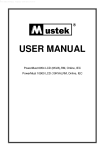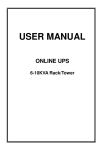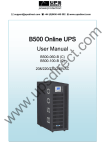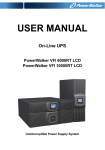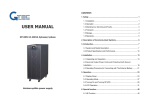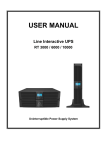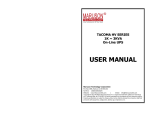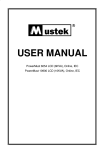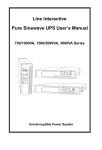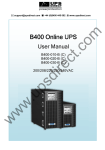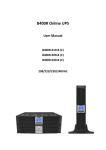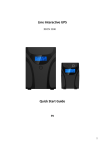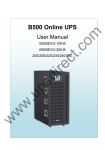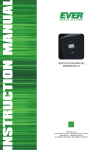Download AP160N-10K-PDU
Transcript
Contents 1. Introduction ............................................................................................ 1 2. Safety Warnings ..................................................................................... 4 USER’S MANUAL For Models AP160N-6K – AP160N-6K-PDU AP160N-10K – AP160N-10K-PDU 2.1 Installation .......................................................................................... 4 2.2 Operation ........................................................................................... 5 2.3 Maintenance, servicing and faults ..................................................... 6 2.4 Transport ............................................................................................ 7 2.5 Storage............................................................................................... 7 2.6 Standards ........................................................................................... 7 3. Installation............................................................................................... 9 3.1 Inspecting the Equipment .................................................................. 9 3.2 Unpacking the Cabinet....................................................................... 9 3.3 UPS Rear Panel............................................................................... 12 3.4 UPS Front Panel .............................................................................. 14 3.5 Rackmount Setup ............................................................................ 15 3.6 Tower Setup ..................................................................................... 19 3.7 Installation of UPS with AC inputs.................................................... 20 4. Power cables connection & Startup ................................................... 22 4.1 Access to terminal block .................................................................. 23 4.2 Common input sources connection ................................................. 23 4.3 Separate input sources connection ................................................. 24 4.4 Frequency converter connection ..................................................... 25 4.5 UPS Initial Startup............................................................................ 25 4.6 Parallel operation ............................................................................. 26 5. Operation .............................................................................................. 26 5.1 Display Panel ................................................................................... 32 5.2 Operating mode ............................................................................... 34 5.3 Turning on and Turning off UPS....................................................... 37 5.4 LCD operation .................................................................................. 39 6. UPS Maintenance ................................................................................. 48 6.1 UPS and Battery Care ..................................................................... 48 6.2 Transporting the UPS....................................................................... 48 6.3 Storing the UPS and Batteries ......................................................... 49 6.4 Testing Batteries .............................................................................. 49 6.5 Recycling the Used Battery or UPS................................................. 50 7. Specifications ....................................................................................... 51 Uninterruptible Power System 8. Troubleshooting ................................................................................... 53 8.1 Typical Alarms and Conditions......................................................... 53 1. Introduction 9. Communication .................................................................................... 58 9.1 RS-232 and USB Communication Ports.......................................... 58 9.2 Network Management Card (Optional) ............................................ 60 9.3 UPS Management Software ............................................................ 60 9.4 REPO Function ................................................................................ 61 This Online R/T Series is an uninterruptible power supply incorporating double-conversion technology. It provides perfect protection specifically for computer equipment, communication systems to computerized instruments. It protects your sensitive electronic equipment from basic power problems such as power failures, power sags, power surges, brownout, and line noise. Power outages can occur when you least expect them and power quality can be erratic. These power problems have the potential to corrupt critical data, destroy unsaved work sessions, and damage hardware - causing hours of lost productivity and expensive repairs. With the Online R/T UPS, you can safely eliminate the effects of power disturbances and guard the integrity of your equipment. The UPS can handle array--network devices flexibility that makes it the best choice for protect your LANs, servers, workstations, and other electrical equipment. Online R/T UPS as Rack installation: Figure 1-1: Online R/T 6K UPS 1 Providing outstanding performance and reliability, the UPS’s unique benefits include: Figure 1-2: Online R/T 10K UPS Online R/T UPS as Tower installation. Figure 1-3: Online R/T 6K UPS l Online UPS design with pure sine wave output. l True online double-conversion technology with high power density, utility frequency independence, and generator compatibility. l Intelligent Battery Management technology that uses advanced battery management to increase battery service life, optimize recharge time. l Selectable High Efficiency mode ( Eco-Mode) of operation. l Start-on-battery capability for powering up the UPS even if utility power is not available. l Standard communication options: one RS-232 communication port, one USB communication port. l Optional connectivity cards with enhanced communication capabilities. l Extended runtime with up to four Extended Battery Modules (EBMs) per UPS. l Optional installation method - Rack & Tower. l Remote shutdown control through the Remote Emergent Power-off (REPO) port. l Parallel with another Online R/T UPS, max amount is 2. l l Optional Rack Slider. Maintenances are simplified by allowing the safe replacement of batteries without powering down the UPS. Figure 1-4: Online R/T 10K UPS 2 3 2. Safety Warnings neutral conductor have to be provided in the building wiring installation. CAUTION: l This is permanently connected equipment , it must be installed by qualified maintenance personnel. l For permanently connected equipment: make sure that a readily accessible disconnect device is incorporated in the building installation wiring. Before performing the procedures in this document, read and follow the safety instructions and important regulatory information in your Safety, Environmental, and Regulatory Information document. IMPORTANT SAFETY INSTRUCTIONS FOR EACH STEP SAVE To reduce the risk of fire, connect only to a circuit provided with branch circuit overcurrent protection with an ampere rating in accordance with the IEC/EN 60934 standard or your local electrical code and have a contact air gap of at least 3 mm. THESE INSTRUCTIONS. 2.1 Installation l Condensation may occur if the UPS is moved directly from a cold to a warm environment. The UPS must be absolutely dry before being installed. Please allow an acclimatization time of at least two hours. l Do not install the UPS near water or in damp environment. l Do not install the UPS where it would be exposed to direct sunlight or near heat. l Do not block ventilation openings in the UPS’s housing. l Place cables in such a way that no one can step on or trip over them. l UPS has provided earthed terminal, in the final installed system configuration, equipotent earth bonding to the external UPS battery cabinets. l An integral single emergency switching device which prevents further supply to the load by the UPS in any operation mode should be provided in the building wiring installation. l An appropriate disconnect device as short-circuit backup protection should be provided in the building wiring installation. l For the equipment connection to an IT power system, a two-pole device which disconnect phase conductors and the 4 Uninterruptible power supply output power 240V 40 amp 2-pole circuit breaker 63 amp 2-pole circuit breaker 6K 10K l You can connect four extended battery modules to the uninterruptible power supply. l Earthing connection is essential before connecting to the building wiring terminal. 2.2 Operation l Do not disconnect the earth conductor cable from the UPS or the building wiring terminals in any time since this would cancel the protective earthing of the UPS system and all connected loads. l The UPS output terminal block may be electrically active even if the UPS system is not connected to the building wiring terminal. l In order to completely disconnect the UPS, firstly press the OFF button, and then disconnect the mains lead. 5 l Ensure that no liquid or other foreign objects can enter the UPS. l The UPS can be operated by any individual without previous experience. 2.3 Maintenance, servicing and faults l l l The UPS operates with hazardous voltages. Maintenance should be carried out only by qualified maintenance personnel. Caution - risk of electric shock. Even after the unit is disconnected from the mains power supply (building wiring terminal), components inside the UPS are still connected to the battery which have potentially dangerous. Before carrying out any kind of service and/or maintenance, please disconnect the batteries. Verify that no current is present and no hazardous voltage exist in the capacitor or BUS capacitor terminals. l Batteries must be replaced only by qualified personnel. l Caution – the risk of electric shock. The battery circuit is not isolated from the input voltage. Hazardous voltage may occur between the battery terminals and the ground. Verify that no voltage is present before servicing! l Batteries have a high short-circuit current and pose a risk of shock. Take all precautionary measures specified as below and any other measures necessary when working with batteries: 1) Remove all jewellery, wristwatches, rings and other metal objects 5) Do not open or destroy batteries. Effluent electrolyte can cause injury to the skin and eyes. It may be toxic. l Please replace the fuse only with the same type and of the same amperage in order to avoid fire hazards. l Do not dismantle the UPS, except the qualified maintenance personnel. 2.4 Transport l Please transport the UPS only in the original packaging (to protect against shock and impact). 2.5 Storage l The UPS must be stockpiled in the room where is ventilated and dry. 2.6 Standards * Safety IEC/EN 62040-1 * EMI Conducted Emission.........................:IEC/EN 62040-2 Category C2 Radiated Emission............................:IEC/EN 62040-2 Category C2 *EMS ESD................................................:IEC/EN 61000-4-2 Level 4 2) Use only tools with insulated grips and handles. RS..................................................:IEC/EN 61000-4-3 3) When changing batteries, replace with the same quantity and the same type of batteries. EFT................................................ :IEC/EN 61000-4-4 Level 4 4) Do not attempt to dispose of batteries by burning them. It could cause explosion. 6 Level 3 SURGE......................................... :IEC/EN 61000-4-5 Level 4 CS................................................. :IEC/EN 61000-4-6 Level 3 7 Power-frequency Magnetic field.... :IEC/EN 61000-4-8 Level 3 Low Frequency Signals..................:IEC/EN 61000-2-2 Warning: This is a product for commercial and industrial application in the second environment-installation restrictions or additional measures may be needed to prevent disturbances. 3. Installation This chapter explains: l Equipment inspection l Unpacking the carton l Checking the Accessory l UPS setup and installation l Connecting the internal battery l Connecting the EBM(Extended Battery Modules) l Installation requirements 3.1 Inspecting the Equipment If any equipment has been damaged during shipment, keep the shipping cartons and packing materials for the carrier or place of purchase and file a claim for shipping damage. If you discover damage after acceptance, file a claim for concealed damage. Note: Check the battery recharge date on the shipping carton label. If the date has passed and the batteries were never recharged, do not use the UPS. Contact your service representative. 3.2 Unpacking the carton CAUTION: If the carton unpacks in a low-temperature of environment it may cause condensation of moisture in or on the cabinet of UPS. Do not install the UPS until the inside and outside of the cabinet is absolutely dry to prevent hazard of electric shock. CAUTION: The cabinet is heavy. Refer following instruction to unpack and move the cabinet from packing carton. Be careful when moving and opening the carton. The unpacking steps are shown as below: 8 9 Step 1: Open the outer carton and remove the accessories out of the CAUTION: carton (see Figure 3-1&3-2). The cabinet is heavy. Lifting the cabinet out of the carton required two persons at least. Online R/T 6K UPS: Step 2: With one person on each side, carefully lift the cabinet out of the outer carton using the handles on the cardboard and set it on a flat, stable surface (see Figure 3-3&3-4). Place the cabinet in a protected area that has adequate airflow and is free of humidity, flammable gas, and corrosion. Lifting the Cabinet: Figure 3-1: Unpacking the carton of 6K UPS Online R/T 10K UPS Figure 3-3: Lifting the Cabinet out of 6K UPS carton Figure 3-2: Unpacking the carton of 10K UPS 10 11 Figure 3-5B: 6K-PDU Rear Panel ( no parallel Card, with maintenance bypass) 10K model Figure 3-4: Lifting the Cabinet out of 10K UPS carton Step 3: Discard or recycle the packaging in a responsible manner, or store it for future use. 3.3 UPS Rear Panel This section shows the rear panel of the Online R/T models. 6K model Figure 3-6A: 10K Rear Panel ( single & parallel, without maintenance bypass) Figure 3-5A: 6K Rear Panel ( single & parallel, without maintenance bypass) 12 13 3.5 Rack mount Setup CAUTION: The cabinet is heavy, so: 1) Remove the battery tray from the UPS before lifting. 2) Lifting the cabinets into the rack requires a minimum of two people. CAUTION: Removing the batteries requiered precautions, which should be performed or supervised by personnel with knowledge of batteries . Keep unauthorized personnel away from batteries. CAUTION: If installing an EBM(Extended Battery Module), install the EBM directly below the UPS. Figure 3-6B: 10K-PDU Rear Panel ( no parallel Card, with maintenance bypass) 3.4 UPS Front Panel This section shows the front panel of the Online R/T UPS. The Online series have the same LCD panel and the same control button. 3.5.1 Install the UPS and EBM (Extended Battery Modules) in a rack: 1. Open the front panel and put it above the UPS. Figure 3-8. Open the front panel (left: 6K Model, right: 10K Model) 2. Remove the battery protection plate: Figure 3-7: The Online R/T UPS Front Panel Figure 3-9. Removing the Battery Protection Plate 14 15 3. Pull the battery tray out using the plastic tabs and then remove the battery tray. Figure 3-12. Install the sliding rails Figure 3-10: Removing the Battery Tray 7. For 10K---Install the battery pack and battery protection plate, then fix the front panel. 4. Install the PDU’s ears to the UPS Figure 3-13. Installing the Cabinet Figure 3-11. Install the PDU’s ears to the UPS 5. Select the proper holes in the rail for positioning the cabinet in the desired location in the rack. Locate the rails at the bottom of the 3U(3U/6K,5U/10K) space allocated for the each UPS and EBM. 8. For 6K---Install the battery tray, and connect the internal battery connector, then fix the protection plate and the front panel. 9. If installing additional UPSs, repeat from Step 1 to Step 8 for each cabinet. 3.5.2 Installing the EBMs Note: A little of arcing may occur when connecting an EBM to the 6. Install the sliding rails in the rack, then install the UPS in the sliding rail. 16 UPS. That is normal and not harmed. Plug the EBM cable into the UPS battery connector quickly and firmly. 17 To install EBMs: 6K Model: CAUTION: 1. Plug the EBM cable into the UPS battery connector Please connect the EBM to protective ground with 10mm2/ 6AWG wire for EBM model firstly. 10K Model: Figure 3-14. Plug the EBM cable into the UPS battery connector 2. Replace UPS’s front panel and EBM’s front panel. Figure 3-16. Plug the EBM cable into the UPS battery connector 3.6 Tower Setup Tower setup as below: Figure 3-15. Replace UPS’s front panel and EBM’s front panel. Figure 3-17. Tower setup 18 19 3.7 Installation of UPS with AC inputs 2) Transformer in the Bypass AC input. CAUTION: Online 6K/10K series support that the UPS can have separate AC inputs. So before connecting wires of seperate AC inputs, you should confirm that their earthing systems are identical. Otherwise, a transformer is necessary. UPS with common Normal and Bypass AC inputs UPS with separate Normal and Bypass AC inputs Ø Earthing systems are identical: Ø Earthing systems are separate: 3) Both of them have transformer Frequency converter (without Bypass AC input) Three different installations can be choosen: 1) Transformer in the Normal AC input. 20 21 4. Power cables connection & Startup This section explains: l l l l l Access to terminal block Common input sources connection Separate input sources connection Frequency converter connection UPS initial startup Use cable cross section and protective device specification Model 6K 10K Protective earthing conductor Min cross section 4mm (10AWG) 2 10mm (6AWG) 2 10mm (6AWG) Input L, N, G Min conductor cross section Output L,N, Min conductor cross section External Battery Cabinet Positive Pole(+), Negative pole(-) Min conductor cross section 4.1 Access to terminal block Access to terminal block: remove the 2 screws of the terminal block 2 4mm (10AWG) Input fuse on UPS 2 60A 2 4mm 10AWG ) 2 cover 80A 2 10mm (6AWG) 4mm (10AWG) 10mm2 (6AWG) 60A 80A External Battery Cabinet Fuse in Positive Pole(+), Negative pole(-) Figure 4-1. Terminals of 6K/10K 4.2 Common input sources connection The UPS does not have an automatic protection device against current backfeed. It is suggested that install an external isolating device ,which is shown in the following illustration. Check for hazardous voltage between all terminals before operating on this circuit. CAUTION: This type of connection must be carried out by qualified electrical personnel. Always connect the earthing wire first 22 23 4.4 Frequency converter connection Figure 4-2. Common input sources connection 4.3 Separate input sources connection Figure 4-4. Frequency converter connection 4.5 UPS Initial Startup CAUTION: This type of connection must be carried out by qualified electrical personnel. Always connect the earthing wire first. To start up the UPS: Verify that the total equipment ratings do not exceed the UPS capacity to prevent an overload alarm. 1. Verify that the internal batterties are connected. 2. If optional EBMs are installed, verify that the EBMs are connected to the UPS. 3. Set the upstream circuit breaker (not included) to the “I” position (ON). The UPS display panel illuminates 4. Verify that the UPS transfers to Bypass mode. 5. Press the 3seconds. button on the UPS front panel for at least The UPS display “ Figure 4-3. Separate input sources connection ” with flashing. 6. Check the UPS display for active alarms or notices. Resolve any active alarms before continuing. See “Troubleshooting” 7. Verify that the UPS is operating normally and load is powered. 24 25 8. If optional EBMs are installed, see “Configuring the UPS for EBMs” to set the number of installed EBMs. The length of the parallel cable have to be less than 3 m. 3) Strictly follow the chapter 4, the wiring requirement of single UPS to perform the wiring of each UPS. Online series recommends setting the date and time. 4) Each UPS need independent battery packs. At initial startup, the UPS sets system frequency according to input line frequency (input frequency auto-sensing is enabled by default). After initial startup, auto-sensing is disabled until manually re-enabled by output frequency setting. 5) Please connect the input and output wires, fix all the wiring according to the Figure 4-5 and make sure all these breakers are open. 9. To change any other factory-set defaults, see “Operation” At initial startup, inut voltage auto-sensing is disbaled by default. When manually enabled by output voltage setting, at the next AC startup the UPS sets output voltage according to input line voltage. After the subsequent startup, auto-sensing is disabled until manually re-enabled by output voltage setting. 10. If you installed an optional REPO, test the REPO function: Activate the external REPO switch. Verify that status change on the UPS display. Deactivate the external REPO switch and restart the UPS. 4.6 Parallel Installation and Operation 4.6.1 Brief introduction of the redundancy The parallel structure is 1+1.As long as the UPS is equipped with parallel cables, up to 2 UPSs can be connected in parallel to configure a sharing and redundant output power. 4.6.2 Installation and operation How to install a new parallel UPS system: 1) Before installing a new parallel UPS system, user need to prepare the input and output wires, the input and output breakers, and the parallel signal cables. 2) Users need to use a special 15-pins communication cable (optional) for this system, which have to have 15 cores, corresponding stitches and shield, as the UPS parallel cable. 26 27 Figure 4-5.a: Parallel systerm wiring diagram of 6K/10K 28 Figure 4-5.b: Parallel System Installation Diagram 29 6) Turn on the input breakers for the two parallel UPS. 7) Pressing button continuously for more than 1 second for one UPS of the system, then the system will start to turn on and enter line mode. Regulate the output voltage of the each UPS separately, and check if the output voltage difference between the two ups is less than 0.5V. If the difference is more than 0.5V, the UPS need to be regulated. 8) 9) If the difference output voltage is less than 0.5V, switch on the output breakers for the two UPS separately and switch on the main O/P breakers, then the system will work normally in parallel. ■ The output wiring requirement as follows: ● When the distance between the UPS in parallel and the breaker panel is less than 10 meters, the length difference between input and output cable of the UPSs is required to be less than 20%. ● When the distance between the UPS in parallel and the breaker panel is more than 20 meters, the length difference between input and output cable of the UPSs is required to be less than 5%. How to join a new UPS to a parallel system: 1) If load cannot be stopped firstly a main external maintenance bypass switch should be installed for the parallel system. 2) Regulate the output voltage of the new UPS: check if the output voltage difference between the new UPS and the existing UPS is less than 0.5V. 3) Ensure the bypass of the parallel system is in tolerance and the button to turn off bypass setting is “enable”, then press the the UPS, then UPS will work in bypass mode. 30 4) 5) 6) 7) 8) Set the main maintenance bypass switch from “UPS” to “ByPass”, then switch off the main output breaker and the input breaker and mains breaker, then the UPS will shut down. Connect the cable and wire of the added UPS according to the Figure.4-5.a and Figure.4-5.b Switch on the input breakers and mains breaker, and make sure that every UPS work in bypass mode. Switch on the O/P breakers & main O/P breaker,transfer the main maintenance bypass switch from “ByPass to “UPS”. button of one UPS, each UPS would start to turn Press the on, after that, the two UPS should work parallel in Line mode. How to remove a single UPS from a parallel system: 1) If load cannot be stopped, firstly a main maintenance bypass switch should be installed for the parallel system. 2) Ensure the bypass is in tolerance and the bypass setting is button to turn off the UPS system, and “enable”, press the the UPS system will work in bypass mode. 3) Transfer the main maintenance bypass switch from “UPS” to “Bypass”, then switch off the output breakers and the input breakers and mains breaker for the two UPS, and the UPS would shut down. 4) Switch off the main O/P breaker and O/P breaker for the UPS system. 5) Remove the wanted UPS, cables and wires. 6) Switch on the mains breaker and input breaker of the reserved UPS, make sure the UPS work in bypass mode. 7) Switch on the O/P breaker and main O/P breaker. 8) Transfer the main maintenance bypass switch from “Bypass” to “UPS”, and press the button to turn on the UPS, and the UPS would start to turn on, then the UPS should work in Line mode. 31 5. Operation Enter main menu 5.1 Display Panel The UPS has a four-button graphical LCD with dual color backlight. Standard back-light is used to light up the display with white text and a blue background. When the UPS has a critical alarm, the backlight changes the text to dark amber and the background to red. See Figure below. Exit main menu Scroll up Scroll down Enter next menu tree Select one menu option Confirm the present setting Figure 5-1. 6-10K Rack On-line UPS Control Panel Table 5-1 Control Button Functions The Button Function Illustration Power on When the unit is no powered and has connected with battery, press this button for > 0,1sec, & <1s to power ON Turn on When the unit is powered ON and in Bypass mode, press this button for >1s to turn ON Turn off When the unit has been turned ON, press this button for >3s to turn OFF 32 When displaying default UPS status summary screen, press this button for >1s to enter the main menu tree Press this button for >1s to exit the present menu to default system status display menu without executing a command or changing a setting Press this button for >0,1sec & <1s to scroll up the menu option Press this button for >0,1sec & <1s to scroll down the menu option Press this button for >0,1sec & <1s to select the present menu option, or enter next menu, but do not change any setting Press this button for >0,1sec & <1s to select the present menu option, or enter next menu, but do not change any setting Press this button for >1s to confirm the edited options and change the setting Table 5-2 Buzzer definition UPS condition Fault active Warning active Battery Mode Bypass output Buzzer status Continuous Beep every second Beep every 4 seconds, if battery low, buzzer Beep every second Beep every 2 minutes The UPS provides useful information about UPS itself, load status, events, measurements, identification, and settings through the front panel display. 33 After powering on, the LCD will display Start-UP for few seconds and then enter to the default page which shows the UPS status summary. The display automatically returns to the default UPS status summary screen when no button has been pressed within 15 minutes. Table 5-3 Status Summary Screens Status Summary Screen Description Normal mode: The UPS is operating in Normal mode from utility power. On the UPS status summary screen it provides the following information: l l l l Status summary, including mode and load Alarm status, if any are present Notes: alarm including fault and warning information Battery and charger status, including battery voltage, charge level and charger status Running information and running time Fig 5-3 Battery mode: When the UPS is running in battery mode, the buzzer beeps once every 4 seconds. Fig 5-4 Bypass with output: Fig 5-5 The UPS does not have the backup function when it is in bypass mode. The power used by the load is supplied from the utility power via internal filter. The UPS will beep once every 2 minutes in bypass mode. Bypass without output: The UPS in bypass mode without output Fig 5-6 Figure 5-2 The default LCD display There are more operation details for LCD is illustrated in the chapter of 5.4 5.2 Operating mode The different graphic symbol could be displayed corresponding to current operating mode or status. 34 Fig 5-7 High Efficiency Mode: After the UPS is turned on, the power used by the load is supplied from the utility power via internal bypass while the utility power is in normal range, so the high efficiency could be gained in the HE mode. Once the mains is loss or abnormal, the UPS would transfer to Line mode or Battery mode and the load is supplied continuously. 1) The function could be enabled through the LCD setting or the 35 Fig 5-8 Overload: software (Winpower, etc.). 2) It is attention that the transfer time of UPS output from HE mode to battery mode is about 10ms. But it is still too long for some sensitive load. Converter mode In converter mode, the UPS would free run with fixed output frequency (50Hz or 60Hz). Once the mains is loss or abnormal, the UPS would transfer to battery mode and the load is supplied continuously. 1) The function could be enabled through the LCD setting or the software (Winpower, etc.). 2) The load have to be derated to 80% in converter mode. Fig 5-11 When the UPS is overload, the alarm will beep twice every second. Some unnecessary loads should be get rid of one by one to decrease the loads connected to the UPS. Battery Test UPS is executing a battery test Fig 5-12 Battery fail: Fig 5-13 if the battery status detected is “bad battery detected” or “battery disconnected”, the symbol of battery failure would be shown and UPS would alarm. Warning: Fig 5-9 Fig 5-10 When the warning occurs, it illustrates that there are some abnormal problems during the operation of UPS. Normally the problems are not fatal and the UPS continues working, but they should be paid attention to, or the UPS may fail. 5.3 Turning on and Turning off UPS Fault: 5.3.1 Turning on UPS with utility When the fault occurs, it illustrates that some fatal problems happened, the UPS would directly cut off the output or transfer to bypass, and keep alarming. The backlight of LCD would also turn to red. 36 Attention: The UPS could only be turning on while connecting with the utility for the first time. Attention: Please switch off the connected loads at first before turning on the UPS, and switch on the loads one by one after the UPS is turned on. Switch off all of the connected loads before turning off the UPS. 1) Check all the connection is correct. 2) Power on the UPS, the fan begins to rotate, LCD will switch-ON. After that, the LCD will show the default UPS status summary screen. 3) Pressing button continuously for more than 1 second, the buzzer will beep 1s, UPS starts to turn on. 37 4) A few seconds later, the UPS turns into Line mode. If the utility power is abnormal, the UPS will transfer to Battery mode without output interruption of the UPS. 5.3.2 Turning on UPS without utility 1) Check all the connection is correct. 2) button continuously for more than 0,1s, the UPS Pressing would be powered on. At this time the fan begins to rotate, LCD will switch-ON . Then LCD will show the default UPS status summary screen after UPS finishing self-test. 3) button continuously for more than 1 second, the Pressing buzzer will beep for 1s, UPS starts to turn on. 4) A few seconds later, the UPS turns into Battery mode. If the utility power comes back, the UPS will transfer to Line mode without output interruption of the UPS. 5.3.3 Turning off UPS with utility 1) 2) 5.4 LCD operation Except the default UPS status summary screen, the user could get more useful information about UPS current status, detailed various measurements, previous event records which ever occurred, UPS own identification, and could change the settings to fit the user own requirements, optimize the function of UPS. 5.4.1 The main menu or In the default UPS status summary screen, when pressing <1s, the detailed information about alarm, the system status, battery would be shown. >1s, In the default UPS status summary screen, when pressing the display would enter main menu tree. The main menu tree includes six branches: UPS status menu, event log menu, measurement menu, control menu, identification menu and setting menu. button continuously for more than 3 seconds and Pressing the buzzer will beep 3s. After that, the UPS will turn into Bypass mode at once. When completing the above action, UPS output voltage is still present. In order to cut off the UPS output, simply cut off the utility power supply. A few seconds later, LCD display shuts down and no output voltage is available from the UPS output terminal. 5.3.4 Turning off UPS without utility 1) 2) To power off the UPS by pressing button continuously for more than 3 second, and the buzzer will beep for 3s. The UPS will cut off the output at once. A few seconds later, LCD shuts down and no voltage is available from the UPS output. 38 39 5.4.2 The UPS status menu By pressing on the menu of “UPS status”, the display would enter the next UPS status menu tree. The content of UPS status menu tree is same as the default UPS status summary menu. By pressing tree. >1s, the display would return the last main menu The detail information about “UPS status”, please see Fig5-14 5.4.3 The event log menu on the menu of “Event log”, the display would By pressing enter the next event menu tree. All the previous events, alarm and fault have been recorded here. The information includes the illustration, the event code, and the or precise time of UPS when the event happened. By press <1s, all the events could be displayed one by one. The max number of record is 50, when the number is larger than 50, the latest will replace the previous. By pressing >1s, the display would return the last main menu tree. Figure. 5-14 Main menu tree 40 41 Figure. 5-16 Measurement menu tree 5.4.5 The control menu Figure. 5-15 Event menu tree 5.4.4 The measurement menu By pressing on the menu of “Measurement”, the display would enter the next measurement menu tree. A lot of detailed useful information could be checked here, Ex. the output voltage and frequency, the output current, the load capacity, the input voltage and frequency, etc. By pressing >1s, the display would return the last main menu tree. 42 on the menu of “Control”, the display would enter By pressing the next control menu tree. 1) Start Battery Test: this is one command that control the UPS to do the battery test. 2) Clear EPO status: once EPO status is enabled, the UPS output would be cut off. To recover to normal status, first EPO connector should be closed, and enter this menu to clear EPO status, then UPS would stop alarm and recover to Bypass model. And UPS needs be turned on by manual operation. 3) Reset Fault status: when fault occurs, UPS would keep in Fault mode and alarm. To recover to normal status, enter this menu 43 to reset error status, then UPS would stop alarm and recover to Bypass mode. And the reason of fault should be checked and deleted before UPS is turned on again by manual operation. 4) Restore factory settings: all the settings would be recover to default factory settings. It could only be done in Bypass mode. 5.4.6 The identification menu By press on the menu of “Identification”, the display would enter the next identification menu tree. The identification information includes UPS serial number, firmware serial number, model type, would be shown here. >1s, the display would return the last main menu tree. By press Figure. 5-18 Identification menu tree 5.4.7 The setting menu Figure. 5-17 Control menu tree 44 Please contact your local distributor for further information before using the settings. Some settings would be changed the specification, and some settings would enable or disable some functions. The unsuitable option setting by user may result in 45 potential failures or protecting function loss, even directly damage the load, battery or UPS. Most of settings could only be done while UPS is in Bypass mode. Example: set rated output voltage value Figure. 5-20 Set rated output voltage value Figure. 5-19 Setting menu tree 46 47 6. UPS Maintenance 3. Remove the UPS front cover 4. Disconnect the internal battery connectors This chapter explains how to: l Care for the UPS and batteries l Transport the UPS 5. Fix the UPS front cover 6.3 Storing the UPS and Batteries l Store the UPS and batteries l Test the batteries l Recycle the used Battery or UPS 6.1 UPS and Battery Care For the best preventive maintenance, keep the area around the UPS clean and dust-free. If the atmosphere is very dusty, clean the outside of the system with a vacuum cleaner. For full battery life, keep the UPS at an ambient temperature of 25°C (77°F) Note: The batteries in the UPS are rated for a 3-5 year service life. The length of service life depends on the frequency of usage and ambient temperature. Batteries used beyond expected service life will have severely reduced runtimes. Replace batteries at least every 4,5 years to keep units running at peak efficiency, first date is based on production date. If you store the UPS for a long period, recharge the battery every 6 months by connecting the UPS to utility power. The batteries charge to 90% capacity in approximately 4 hours. However, it is recommended that the batteries charge for 48 hours after long-term storage. Check the battery recharge date on the shipping carton label. If the date has passed and the batteries were never recharged, do not use the UPS. Contact your service distributor. When to Replace Batteries When the status summary screen displays the UPS fault icon with the “Service Battery” alarm and the audible alarm sounds continuously, the batteries may need replacement. Contact your service representative to change or order new batteries. 6.4 Testing Batteries For a battery test, please check: l The batteries must be fully charged. 6.2 Transporting the UPS NOTE: The internal UPS batteries MUST be disconnected before transport. l The UPS must be in Normal mode with no active alarms. l The load must be higher than 10%. CAUTION: The following procedure should be performed or supervised by personnel knowledgeable about batteries and the required precaution. Keep unauthorized personnel away from batteries. To test batteries: 1 Connect the UPS to utility power for at least 48 hours to charge the batteries. If the UPS requires any type of transportation, the batteries must be disconnected (but not removed) before the unit is transported: 2 button for one second to go to the main menu Press the selection and scroll down to the Control menu using the button. 3 Press the 4 Use the 1. Verify that the UPS is off and disconnected from utility power. 2. Place the UPS on a flat, stable surface with the front of the cabinet facing you. 48 button to enter the Control menu. button to scroll to the Battery Test option. 49 5 Press the button to start the battery test. During the battery test, the UPS transfers to Battery mode and discharges the batteries for 25% of the original expected runtime. The status screen displays “Battery test running” and the percentage of the test completed. The results display on the UPS status screen as completing. 7. Specifications This chapter provides the following specifications: l l l l Model list General Specification Electrical Performance Environmental and Safety 6.5 Recycling the Used Battery or UPS Contact your local recycling or hazardous waste center for information on proper disposal of the used battery or UPS. 7.1 Electrical specification Model Online RT 6K Power Capacity 6KVA/5.4KW Online RT 10K Output Voltage Range 208VAC/220VAC/ 208VAC/220VAC/ 230VAC/ 240VAC 230VAC/ 240VAC Frequency Voltage Distortion 10KVA/9KW 50/60Hz 50/60Hz <5%@Nonlinear load <5%@Nonlinear load <2%@Linear load <2%@Linear load Line Mode: Over Load 2mins 102% ~ 130% 30s 130% ~ 150% 100ms >150% Battery Mode: 10s 102% ~ 130% 100ms >130% Efficiency Line mode >92% >93% ECO mode >96% >97% Battery mode >89% >90% Input 50 Input wire 1 Ph (L1,L2/N)+ PE Input Type Support dual input Phase Single Voltage Range 176-276Vac Frequency Range (45~55)/(54~66)Hz 51 26.4A@230Vac Current 44.0A@230Vac ≥ 0,99 @100% Nominal Load ≥ 0,98 @50% Nominal Load Power Factor ≥ 0,95 @25% Nominal Load < 5 %@Full load and battery full charged THDI Battery & Charger Battery 180VDC / 5Ah 240VDC / 9Ah Current 39A 48A Charger current 1A 1.7A 7.2 Dimension and Weight Dimension (W*D*H) mm 438*698*129 438*704*215.5 Net Weight (KG) 46 82.5 Gross Weight (KG) 50 87.5 7.3 Operating Environment Item 6K/10K Standards/Comments Cooling Force Air Cooling / Operating Temperature -15°C~60°C UPS Temperature 0~35°C Battery 0-95% No condensing Altitude Acoustic Noise The control panel provides troubleshooting information from two main menus: l UPS status menu: Access to all active alarms l Event Log menu: Access to the most recent 50 events, which may include active and closed alarms 8.1 Typical Alarms and Conditions Alarm or Condition Possible cause Action ON Maintenance Bypass Alarm Code: 72 UPS was manually commanded to switch to bypass and will remain in bypass until commanded out of bypass Check the maintain bypass switch status In Battery Mode Alarm Code: 62 A utility failure has occurred and the UPS is in Battery mode. In ECO Mode Alarm Code: 63 The UPS is on bypass while operating on the High Efficiency setting. EPO Active Alarm Code: 71 The external contacts in the rear of the UPS are configured for REPO operation and they have been activated. operating mode Storage Humidity The online series UPS is designed for durable, automatic operation and issues alarms to alert you whenever potential operating problems occur. Usually the alarms shown by the control panel do not mean that the output power is affected. Instead, they are preventive alarms intended to alert the user. Active alarms are accompanied by an audible buzzer. Nominal power & continuous 0°C ~ 40 °C Range Relative 8. Troubleshooting <1000m for Nominal power <55dB Over 1000 m the power derating is 1 % every 100 m / 52 53 The UPS is powering the equipment with battery power. Prepare your equipment for shutdown. The equipment transferred to bypass utility power as a normal function of High Efficiency operation. Battery mode is available and your equipment is protected. Check the EPO connector status Site Wiring Fault Alarm Code: 04 Site Fault detection is supported on all models anytime there is a Grounding Neutral connection. Alarm triggers when the difference between ground and neutral voltage is > 15v. Site Fault detection should be enabled by default. It can still be enabled / disabled from the LCD settings menu. Reconnect all input wires Utility Abnormal Alarm Code: 02 Utility is out of the tolerance of input Check input mains condition Back feed Alarm Code:93 UPS has a unexpected bypass current on battery mode Transfer to maintenance bypass and call service. Battery Disconnect Alarm Code:11 Battery voltage is lower than the batteries disconnected level defined for this UPS. This may be due to a blown fuse, intermittent battery connection or battery cable being disconnected. Verify that all batteries are properly connected. If the condition persists, contact your service representative. The UPS is in Battery mode and the battery is running low This warning is approximate, and the actual time to shutdown may vary significantly. Depending on the UPS load and number of Extended Battery Modules(EBMs), the “Battery Low” warning may occur before the batteries reach 25% capacity Battery low Alarm Code:12 Service Battery Alarm Code:13 A faulted battery string has been detected and as a result the battery charger has been disabled until it is replaced 54 Contact your service representative Output Overload Alarm Code:41 Output is overload. Remove some of the equipment from the UPS. The UPS continues to operate, but may switch to Bypass mode or shutdown if the load increases. The alarm resets when the condition becomes inactive. Inv Overload Fault Alarm Code:42 UPS has transferred to bypass or fault mode because of overload in inverter mode The UPS transfers to Battery mode if supporting the load. Remove some of the equipment from the UPS Byp Overload Fault Alarm Code:43 UPS has cut off the output and transferred to fault mode because of overload in bypass mode or HE mode. Remove some of the equipment from the UPS Output Short Circuit Alarm Code:31 Indicates that the UPS has detected abnormally low impedance placed on its output and considers it a short circuit Remove all the loads. Turn off the UPS. Check if UPS output and loads is short circuit. Ensure short circuit is removed before turning on again. Fan Failure Alarm Code:84 Indicates that the fan could not work normally. Check fans of UPS Heatsink Over Temperature Alarm Code:81 Indicates that the temperature of heatsink is too high, UPS will get over temperature fault soon. If the UPS transferred to Bypass mode, If the condition persists, shut down the UPS. Clear vents and remove any heat sources. Allow the UPS to cool. Ensure the airflow around the UPS is not restricted. Restart the UPS. Ambient Over Temperature Alarm Code:82 Indicates that the ambient temperature is higher than the operation temperature on specification 55 BUS Over Voltage Alarm Code:21 Indicates that the UPS get BUS over voltage fault because of BUS. The UPS transfers to Bypass mode if supporting the load BUS Under Voltage Alarm Code:22 Indicates that the UPS get BUS under voltage fault The UPS transfers to Bypass mode if supporting the load BUS Unbalance Alarm Code:23 Indicates that the positive BUS voltage and negative BUS voltage are too lopsided to fault The UPS transfers to Bypass mode if supporting the load BUS Short Alarm Code:24 Indicates that the BUS voltage decrease very fast Contact your service representative BUS Softstart Fail Alarm Code:25 Indicates that the BUS could not soft start successfully Contact your service representative Inv Over Voltage Alarm Code:32 Indicates that the UPS get invert over voltage fault The UPS transfers to Bypass mode if supporting the load Indicates that the UPS get inverter under voltage fault Indicates that the inverter could not start successfully The UPS transfers to Bypass mode if supporting the load Inv Under Volatge Alarm Code:33 Inv Softstart Fail Alarm Code:34 Indicates that the UPS has confirmed the charger has failed The UPS turns off the charger until the next power recycle. Contact your service representative Battery Over Voltage Alarm Code:16 Indicates that the battery voltage is too high The UPS will turn off the charger until the battery voltage is normal Fatal eeprom Fault Alarm Code:A3 Indicates that the UPS could not read eeprom successfully Contact your service representative In parallel system,power of UPS is negative Redundancy mode,the fault UPS turn to fault mode without output Increase mode,UPS1& UPS2 turn to fault mode 56 In parallel system, parallel cable disconnect Disconnect parallel cable one turn to fault mode Parallel system battery status Alarm Code: E6 UPS1 connect battery, UPS2 without battery Check battery connect status Line input different Alarm Code: E7 Parallel system,UPS1 line ok,UPS2 line loss Check the line input Bypass input different Alarm Code: E8 Parallel system,UPS1 bypass ok,UPS2 Bypass loss Bypass different,not allow turn on UPS. Check bypass input Power strategy different Alarm Code: E9 Parallel system,UPS OP mode(normal , converter,HE) different Check UPS OP mode, Keep OP mode be the same Rate power different Alarm Code: EA Parallel system rate power different Rate power different,not allow turn on UPS. Keep rate power be the same HE in parallel Alarm Code: EB Parallel system,OP mode set as HE HE not allow in parallel system,change OP mode Contact your service representative Charger Fail Alarm Code:15 Negative power Fault Alarm Code: E1 Parallel cable loss Alarm Code: E2 57 9. Communication 7 8 9 This chapter contains: l Communication ports (RS-232 and USB) l Network Management Card (Optional) l UPS Management Software l REPO Not used On Battery signal/Main failure Vdc Power(+12V) This pin is connected via a jumper to pin 2 of SNMP connector -Out Out 9.1 RS-232 and USB Communication Ports To establish communication between the UPS and a computer, connect your computer to one of the UPS communication ports using an appropriate communication cable. When the communication cable is installed, power management software can exchange data between your computer and the UPS. The software will obtain the detailed information of the UPS on the status of the power environment. If power emergency occurs, the software initiates the saving of all data and an orderly shutdown of the equipment. Figure.9-2 RS-232 Communication Port The cable pins for the RS-232 communication port are identified in figure 9-1, and the pin functions are described in Table 3. Figure.9-1 RS-232 Communication Port (DB-9 Connector) Table 3 RS-232 Communication Port Pin Assignment Pin Number 1 2 3 5 Signal Name RxD TxD GND Function Battery Low signal Transmit to ext. PC/Server Receive from ext. PC/Server Signal common 58 Direction from the UPS Out RS232 RS232 -- Figure. 9-3 Pin1/Pin8 typical application Notes: The Pin 1 & 8 are driven by Transistor ( aren’t a relay), so maximum voltage of ‘+V’ is 30Vdc, the maximum current is 45mA. 59 9.2 Network Management Card (Optional) Network Management Card allow the UPS to communicate with different types of devices in variety of networking environments. The Online series has one available communication bay for the following connectivity cards: l Connect UPS- MS Web/SNMP Card – has SNMP and HTTP capabilities as well as monitoring through a Web browser interface; connects to a twisted-pair Ethernet (10/100BaseT) network. In addition. l This series UPS has AS400/Relay card (as optional accessory) for AS400 communication protocol, or for standard Relay alarm signal. Please contact your local distributor for details. 9.3 UPS Management Software Free Software Download – WinPower WinPower is a new software for UPS monitoring, which provides user-friendly interface to monitor and control your UPS. This unique software provides safely auto shutdown for multi-computer systems while power failure. With this software, users can monitor and control any UPS on the same LAN no matter how far from the UPSs. Installation procedure: 1. Go to the website: http://www.ups-software-download.com/ 2. Choose the operation system you need and follow the instruction described on the website to download the software. 3. When downloading all required files from the internet, enter the serial No: 511C1-01220-0100-478DF2A to install the software. When you finish installation, restart your computer, the WinPower software will appear as a green plug icon located in the system tray, near the clock. 9.4 REPO Function The Remote Emergence Power Off interface provides an emergence power off function. When the REPO function is enabled, once the EPO port is pulled out, the UPS would shut off the output and enter into EPO mode, and the UPS would not respond anything command unless the port is plugged back. 60 61 614-08108-00 62

































